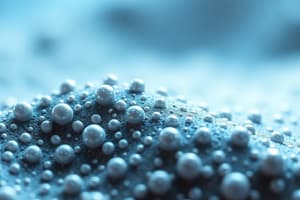Podcast
Questions and Answers
How does particle size influence the optical properties of nanoparticles?
How does particle size influence the optical properties of nanoparticles?
Increasing particle size leads to higher reflectance, while the reflectance decreases with an increasing refractive index.
What is the optimal particle size for magnetic nanoparticles, and why?
What is the optimal particle size for magnetic nanoparticles, and why?
The optimal particle size for magnetic nanoparticles is less than 35 nm due to their enhanced magnetic performance at this size.
Explain how lattice parameters can change in metal nanoparticles with varying sizes.
Explain how lattice parameters can change in metal nanoparticles with varying sizes.
Lattice parameters may change when nanoparticles contain metal oxides on the surface, leading to interfacial stress due to mismatches with the metal's lattice.
What mechanical advantages do nanoparticles have over bulk materials?
What mechanical advantages do nanoparticles have over bulk materials?
How can the mechanical properties of organic compounds be improved using nanoparticles?
How can the mechanical properties of organic compounds be improved using nanoparticles?
What determines the magnetic value in multicomponent nanoparticles?
What determines the magnetic value in multicomponent nanoparticles?
What is a major factor influencing the mechanical properties of nanoparticles?
What is a major factor influencing the mechanical properties of nanoparticles?
Why is the particle size change generally small with minimal effects on lattice parameters?
Why is the particle size change generally small with minimal effects on lattice parameters?
What is the primary technique used in the gas phase method for producing TiO2 thin films?
What is the primary technique used in the gas phase method for producing TiO2 thin films?
What are the advantages of using the microwave radiation method for producing nanomaterials?
What are the advantages of using the microwave radiation method for producing nanomaterials?
How does the sol-gel method allow for the introduction of dopants in nanomaterials?
How does the sol-gel method allow for the introduction of dopants in nanomaterials?
What are some factors that can affect gel formation in the sol-gel technique?
What are some factors that can affect gel formation in the sol-gel technique?
What is one benefit of producing TiO2 thin films using E-beam evaporation compared to the CVD method?
What is one benefit of producing TiO2 thin films using E-beam evaporation compared to the CVD method?
What is the role of the colloidal suspension in the sol-gel process?
What is the role of the colloidal suspension in the sol-gel process?
In the microwave radiation method, how can high-quality rutile rods be created?
In the microwave radiation method, how can high-quality rutile rods be created?
Why is the sol-gel technique noted for its scalability and high purity in nanomaterials?
Why is the sol-gel technique noted for its scalability and high purity in nanomaterials?
What are the main categories of nanomaterials mentioned in the text?
What are the main categories of nanomaterials mentioned in the text?
Name two examples of metal and metal oxide nanomaterials.
Name two examples of metal and metal oxide nanomaterials.
What characteristic distinguishes organic nanomaterials from carbon-based or inorganic nanomaterials?
What characteristic distinguishes organic nanomaterials from carbon-based or inorganic nanomaterials?
What is a nanocomposite?
What is a nanocomposite?
What benefits do ceramic nanomaterials exhibit due to their nanoscale dimensions?
What benefits do ceramic nanomaterials exhibit due to their nanoscale dimensions?
How does the doping concentration affect Ti-doped BiFeO3 nanoceramics?
How does the doping concentration affect Ti-doped BiFeO3 nanoceramics?
Why are noncovalent bonds significant in organic nanomaterials?
Why are noncovalent bonds significant in organic nanomaterials?
What is the size definition of nanoceramic materials?
What is the size definition of nanoceramic materials?
According to Gleiter's classification, what primarily influences the characteristics of nanomaterials?
According to Gleiter's classification, what primarily influences the characteristics of nanomaterials?
What are the two main categories for classifying the origin of nanomaterials?
What are the two main categories for classifying the origin of nanomaterials?
Name two natural sources where nanomaterials can be found.
Name two natural sources where nanomaterials can be found.
What is a major advantage of synthetically produced nanomaterials?
What is a major advantage of synthetically produced nanomaterials?
What does the classification by Pokropivny and Skorokhod suggest about nanomaterials?
What does the classification by Pokropivny and Skorokhod suggest about nanomaterials?
What concern arises from the synthetic methods in the production of nanomaterials?
What concern arises from the synthetic methods in the production of nanomaterials?
What are the primary goals in the synthesis of nanomaterials?
What are the primary goals in the synthesis of nanomaterials?
How do synthetic nanomaterials differ in behavior compared to natural nanomaterials?
How do synthetic nanomaterials differ in behavior compared to natural nanomaterials?
What are the two major methods used in the synthesis of nanomaterials?
What are the two major methods used in the synthesis of nanomaterials?
What is a significant disadvantage of the top-down method for producing nanomaterials?
What is a significant disadvantage of the top-down method for producing nanomaterials?
How does the bottom-up method improve the properties of nanomaterials?
How does the bottom-up method improve the properties of nanomaterials?
What processes are primarily involved in the top-down approach to nanomaterial production?
What processes are primarily involved in the top-down approach to nanomaterial production?
Why is the bottom-up method considered environmentally friendly?
Why is the bottom-up method considered environmentally friendly?
What challenges are associated with the top-down method in terms of crystallographic structure?
What challenges are associated with the top-down method in terms of crystallographic structure?
Why is cost a consideration in synthesizing nanomaterials?
Why is cost a consideration in synthesizing nanomaterials?
What is the primary goal of synthesizing nanomaterials according to researchers?
What is the primary goal of synthesizing nanomaterials according to researchers?
What is the primary definition of nanomaterials?
What is the primary definition of nanomaterials?
Describe one major difference between nanomaterials and bulk materials.
Describe one major difference between nanomaterials and bulk materials.
Name two types of nanomaterials classified by their composition.
Name two types of nanomaterials classified by their composition.
What is one example of a production method for nanomaterials?
What is one example of a production method for nanomaterials?
Identify one characterization technique used for analyzing nanoparticles.
Identify one characterization technique used for analyzing nanoparticles.
List one application of nanomaterials in the biomedical field.
List one application of nanomaterials in the biomedical field.
What is a significant advantage of using nanotechnology?
What is a significant advantage of using nanotechnology?
How are nanomaterials utilized in environmental remediation?
How are nanomaterials utilized in environmental remediation?
What role do antimicrobial nanopowders play in medicine?
What role do antimicrobial nanopowders play in medicine?
What is one disadvantage of nanotechnology?
What is one disadvantage of nanotechnology?
Name one method for synthesizing nanomaterials using the top-down approach.
Name one method for synthesizing nanomaterials using the top-down approach.
Identify a key component of Fourier Transform Infrared (FTIR) Spectroscopy.
Identify a key component of Fourier Transform Infrared (FTIR) Spectroscopy.
What is the purpose of using laser ablation in nanomaterial synthesis?
What is the purpose of using laser ablation in nanomaterial synthesis?
Flashcards
Carbon Nanomaterials
Carbon Nanomaterials
Nanomaterials composed entirely of carbon atoms, with a focus on their structure and size.
Metal and Metal Oxide Nanomaterials
Metal and Metal Oxide Nanomaterials
Metal and metal oxide nanomaterials are inorganic nanoparticles, such as gold, silver, titanium dioxide, and zinc oxide.
Organic Nanomaterials
Organic Nanomaterials
Mainly composed of organic matter, without carbon or inorganic compounds. They have weak, non-covalent bonds that can be easily manipulated.
Nanocomposites
Nanocomposites
Signup and view all the flashcards
Ceramic Nanomaterials
Ceramic Nanomaterials
Signup and view all the flashcards
Doping
Doping
Signup and view all the flashcards
Elimination of Oxygen Vacancies
Elimination of Oxygen Vacancies
Signup and view all the flashcards
Porous Material
Porous Material
Signup and view all the flashcards
What are nanomaterials?
What are nanomaterials?
Signup and view all the flashcards
What is Nanotechnology?
What is Nanotechnology?
Signup and view all the flashcards
How do nanomaterials differ from bulk materials?
How do nanomaterials differ from bulk materials?
Signup and view all the flashcards
What are carbon nanomaterials?
What are carbon nanomaterials?
Signup and view all the flashcards
What are Metal and Metal Oxide Nanomaterials?
What are Metal and Metal Oxide Nanomaterials?
Signup and view all the flashcards
What are Organic Nanomaterials?
What are Organic Nanomaterials?
Signup and view all the flashcards
What are Nanocomposites?
What are Nanocomposites?
Signup and view all the flashcards
What are Ceramic Nanomaterials?
What are Ceramic Nanomaterials?
Signup and view all the flashcards
What are Semiconductor Nanomaterials?
What are Semiconductor Nanomaterials?
Signup and view all the flashcards
What are Polymeric Nanomaterials?
What are Polymeric Nanomaterials?
Signup and view all the flashcards
How are Nanomaterials Classified based on size and dimensions?
How are Nanomaterials Classified based on size and dimensions?
Signup and view all the flashcards
How are Nanomaterials classified based on their origin?
How are Nanomaterials classified based on their origin?
Signup and view all the flashcards
What are the main methods for synthesizing Nanomaterials?
What are the main methods for synthesizing Nanomaterials?
Signup and view all the flashcards
What is the Hydrothermal method of Nanomaterial synthesis?
What is the Hydrothermal method of Nanomaterial synthesis?
Signup and view all the flashcards
What is the Solvothermal method of Nanomaterial synthesis?
What is the Solvothermal method of Nanomaterial synthesis?
Signup and view all the flashcards
Gleiter's Classification
Gleiter's Classification
Signup and view all the flashcards
Pokropivny and Skorokhod Classification
Pokropivny and Skorokhod Classification
Signup and view all the flashcards
Natural Nanomaterials
Natural Nanomaterials
Signup and view all the flashcards
Synthetic Nanomaterials
Synthetic Nanomaterials
Signup and view all the flashcards
Synthesis of Nanomaterials
Synthesis of Nanomaterials
Signup and view all the flashcards
Characterization of Nanomaterials
Characterization of Nanomaterials
Signup and view all the flashcards
Doping of Nanomaterials
Doping of Nanomaterials
Signup and view all the flashcards
Top-Down Method
Top-Down Method
Signup and view all the flashcards
Bottom-Up Method
Bottom-Up Method
Signup and view all the flashcards
Precise Chemical Synthesis
Precise Chemical Synthesis
Signup and view all the flashcards
Environmentally Friendly and Economical Methods
Environmentally Friendly and Economical Methods
Signup and view all the flashcards
Uniformity in Nanomaterial Production
Uniformity in Nanomaterial Production
Signup and view all the flashcards
Surface Structure Control
Surface Structure Control
Signup and view all the flashcards
Crystallographic Losses in Nanomaterial Production
Crystallographic Losses in Nanomaterial Production
Signup and view all the flashcards
Functionality in Nanomaterial Production
Functionality in Nanomaterial Production
Signup and view all the flashcards
Gas Phase Method
Gas Phase Method
Signup and view all the flashcards
Electron Beam (E-beam) Evaporation
Electron Beam (E-beam) Evaporation
Signup and view all the flashcards
Microwave Radiation Method
Microwave Radiation Method
Signup and view all the flashcards
Conventional Sol-Gel Method
Conventional Sol-Gel Method
Signup and view all the flashcards
Physical Vapor Deposition (PVD)
Physical Vapor Deposition (PVD)
Signup and view all the flashcards
Chemical Vapor Deposition (CVD)
Chemical Vapor Deposition (CVD)
Signup and view all the flashcards
Gel Maturation
Gel Maturation
Signup and view all the flashcards
Scattering in nanoparticles
Scattering in nanoparticles
Signup and view all the flashcards
Reflectance in nanoparticles
Reflectance in nanoparticles
Signup and view all the flashcards
Magnetic properties of nanoparticles
Magnetic properties of nanoparticles
Signup and view all the flashcards
Magnetic moment in nanoparticles
Magnetic moment in nanoparticles
Signup and view all the flashcards
Mechanical properties of nanoparticles
Mechanical properties of nanoparticles
Signup and view all the flashcards
Hardness in nanoparticles
Hardness in nanoparticles
Signup and view all the flashcards
Tensile strength in nanoparticles
Tensile strength in nanoparticles
Signup and view all the flashcards
Improving organic materials with nanoparticles
Improving organic materials with nanoparticles
Signup and view all the flashcards
Study Notes
Nanomaterials (Properties and Uses)
- Nanomaterials are substances with grain sizes in the billionths of a meter
- They possess unique properties in terms of their chemical, physical, and mechanical properties compared to their bulkier counterparts
- These properties can be exploited in various applications for structural and non-structural packages
- Applications include next-generation laptop chips, kinetic energy penetrators, better insulation, flat-panel displays, advanced cutting tools, pollution remediation, and more energy-efficient batteries
- Nanomaterials are classified into seven categories: Carbon, Metal and metal oxide, Organic, Nanocomposites, Ceramic, Semiconductor, and Polymeric
- Synthetic nanomaterials can be produced in large quantities with diverse shapes and sizes, offering precise control over chemical and physical properties
- Top-down and bottom-up methods are commonly used for synthesis
- Top-down approaches involve breaking down bulk materials into smaller particles
- Bottom-up approaches involve assembling atoms or molecules to create nanomaterials with controlled size, shape, and distribution
- Characterization techniques such as SEM, TEM, XRD, FTIR, TGA and EDX are used for evaluating properties of nanomaterials
- Nanoparticles have unique electronic, optical, magnetic, and mechanical properties that differ from their bulk counterparts due to their high surface area to volume ratio, and quantum effects
- Nanomaterials are finding applications in electronics, medicine, and other fields
- Nanotechnology is an interdisciplinary field with applications in many areas, including manufacturing, construction, and environmental remediation.
List of Contents
- Chapter One: Introduction of Nanomaterials: Definition, History, Main differences between nanomaterials and bulk materials, Types and Classification of nanomaterials, Carbon, Metal and metal oxide, Organic, Nanocomposites, Ceramic, Semiconductor, and Polymeric nanomaterials, Classification of Nanomaterials, Dimensions and Sizes, Origin of Nanomaterials, Natural vs Synthetic Nanomaterials
- Chapter Two: Synthesis of Nanomaterials: Methods and Characterizations: Introduction, Methods to Synthesize Nanomaterials, Top-Down Method, Bottom-up Methods, (Specific methods like Hydrothermal, Solvothermal, Chemical Vapor Deposition, Thermal Decomposition, Pulsed Laser Ablation, Templating, Combustion, Gas Phase, Microwave Radiation and Conventional Sol-Gel) Characterization of Nanoparticles
- Chapter Three: Methods of Detection of Nanomaterials: Introduction, Scanning Electron Microscopy (SEM), Transmission Electron Microscopy (TEM), Fourier Transform Infrared (FTIR) Spectroscopy, X-Ray Diffraction (XRD)
- Chapter Four: Applications, Advantages and Disadvantages of Nanomaterials: Introduction, Electronics, Displays, High energy density batteries, High- sensitivity sensors, Transportation and telecommunication, Car Tire, Car Bumpers, Imaging, Biomedical Applications, Drug Delivery, Gene Transfection, Medical Imaging, Nasal Vaccination, Nucleic Acid Sequence and Protein Detection, Treatment for local anesthetic toxicity, Pollution Remediation (Water Remediation, Elimination of pollutants), Cosmetics, Coatings (Self-cleaning windows, Scratch resistant materials), Textiles, Insulation materials, Nanocomposites, Paints Mechanical Engineering (Cutting Tools, Lubricants)
- Conclusions and Recommendations:
- References: (List of citations)
List of Abbreviations
- (List of abbreviations and their meanings)
Studying That Suits You
Use AI to generate personalized quizzes and flashcards to suit your learning preferences.




